Culture History
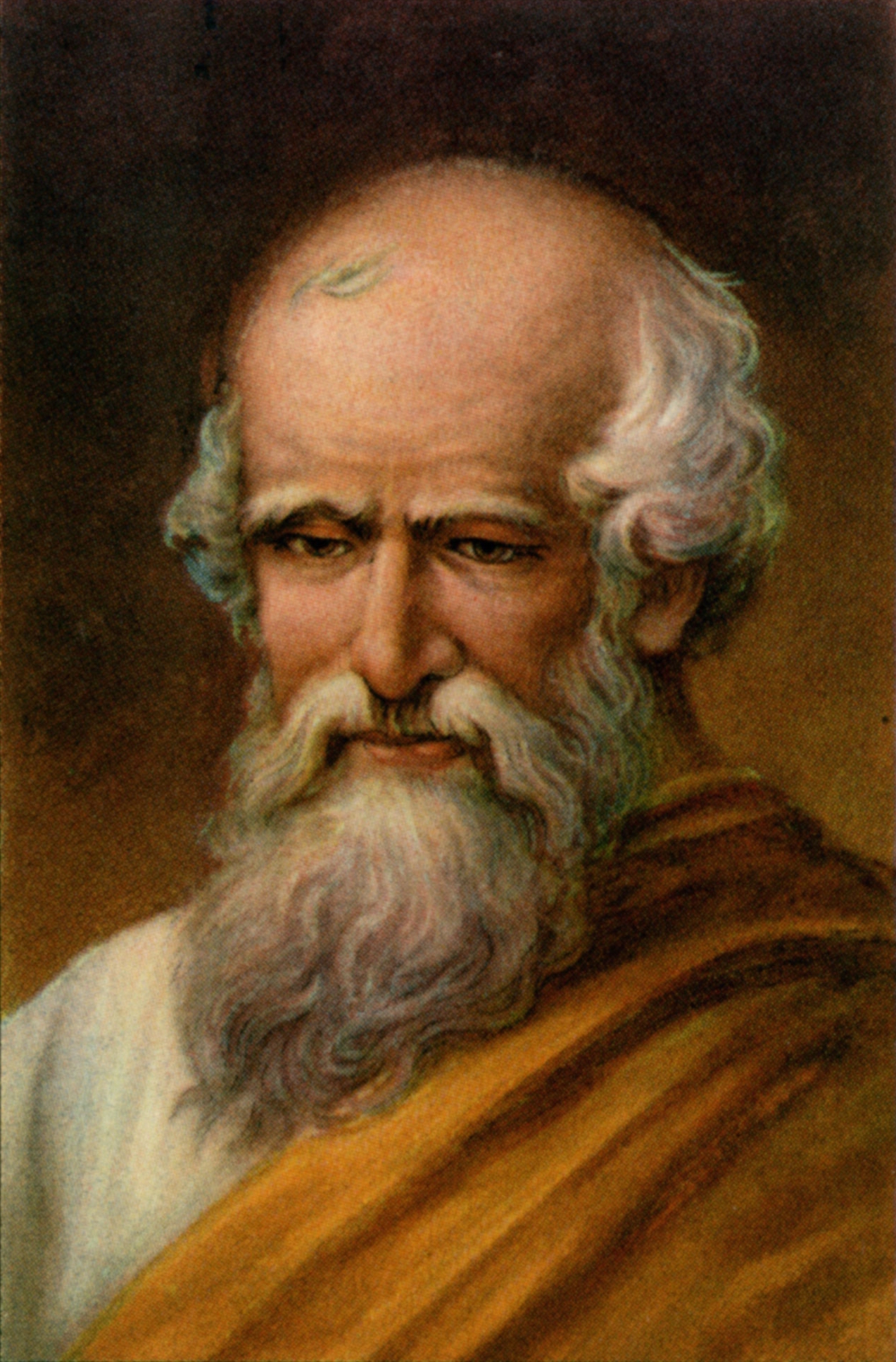
Archimedes (c. 287-212 BCE) was an ancient Greek mathematician, physicist, engineer, and inventor. Renowned for his contributions to mathematics and physics, Archimedes is best known for his work on geometry, including the determination of the area of a circle and the volume of a sphere. He formulated fundamental principles in hydrostatics and is famous for the principle of buoyancy, often expressed as “Archimedes’ Principle.” Additionally, he designed various mechanical devices, demonstrating his innovative thinking and impact on both theoretical and practical aspects of science and mathematics in antiquity.
Growing up in a city with strong connections to both Greek and Roman cultures, Archimedes was exposed to a rich intellectual environment. His early education likely involved the study of mathematics, science, and philosophy. Although details about his early life are scarce, his thirst for knowledge and innate curiosity set the stage for his later achievements.
One of Archimedes’ most famous contributions to mathematics is his work on geometry. He made significant advancements in understanding the properties of circles and spheres, laying the foundation for integral calculus centuries later. Archimedes is credited with the discovery of the relationship between the circumference and diameter of a circle, known as π (pi). He approximated the value of pi with remarkable accuracy, using a method that involved inscribing and circumscribing polygons around a circle.
Archimedes was not only a theoretical mathematician but also an ingenious inventor and practical problem solver. His most famous inventions include the Archimedean screw, a device for raising water that is still used in some parts of the world today. This helical pump, when rotated, could lift water from a lower to a higher elevation. It played a crucial role in irrigation and drainage systems, showcasing Archimedes’ ability to apply mathematical principles to solve real-world problems.
During his lifetime, Archimedes was also involved in various engineering projects. His mechanical inventions, such as compound pulleys and the odometer, demonstrated his understanding of physics and his knack for creating innovative solutions. The odometer, in particular, was a sophisticated device used to measure distances traveled. It featured a series of gears and rotating mechanisms that recorded the number of rotations, providing an estimate of the distance covered.
Archimedes’ prowess in mathematics and physics extended to his exploration of the principles of statics and hydrostatics. Legend has it that he discovered the principle of buoyancy while taking a bath. Excited by his revelation, he is said to have run through the streets of Syracuse shouting “Eureka!” meaning “I have found it.” This anecdote underscores the importance of his discovery of buoyancy, explaining why objects float or sink in fluids.
One of Archimedes’ most remarkable achievements in the realm of physics was his formulation of the law of the lever. He demonstrated that with a sufficiently long lever, a smaller force could lift a larger load. This foundational principle has applications in various fields, from engineering to modern physics.
The city-state of Syracuse, where Archimedes spent much of his life, was frequently embroiled in conflicts with other Greek states and later with the expanding Roman Republic. Archimedes played a crucial role in the defense of Syracuse during the Second Punic War, where the Romans, led by General Marcellus, besieged the city. Archimedes’ ingenuity and mastery of defensive mechanisms were put to the test during this conflict.
He designed a series of advanced war machines, including the famous “Archimedes’ Claw,” which was said to have been capable of lifting Roman ships out of the water and tipping them over. Although the historical accuracy of some of these accounts is debated, there is consensus that Archimedes’ inventions were instrumental in the defense of Syracuse for an extended period.
Unfortunately, the brilliance of Archimedes could not save him from the tumultuous times in which he lived. Syracuse eventually fell to the Roman forces in 212 BCE. According to historical accounts, Archimedes met his tragic end during the sack of the city. The circumstances surrounding his death vary in different historical sources, but most agree that he was killed by a Roman soldier, despite orders to spare his life issued by General Marcellus.
Archimedes’ death marked the loss of a genius whose contributions to science, mathematics, and engineering were ahead of his time. His works were preserved and later transmitted to the medieval Islamic world, where scholars built upon his ideas and laid the groundwork for the European Renaissance. The preservation of Archimedes’ writings, including his treatises on mathematics and physics, in medieval manuscripts attests to the enduring impact of his intellectual legacy.
The Archimedean solids, a class of convex polyhedra, are named in honor of his contributions to geometry. These solids have a unique property: they are identical in their vertices, edges, and faces, making them an intriguing subject of study in geometry and crystallography. Archimedes’ influence on the development of geometry continued to inspire mathematicians for centuries, with his works serving as a cornerstone for later mathematical advancements.

Leave a Comment Cancel reply
You must be logged in to post a comment.
Biography Online

Archimedes Biography

Archimedes was born in Syracuse, a Greek city-state in Sicily. He was educated at Alexandria, Egypt – famed for its knowledge and learning. He then returned to Syracuse where he became famed as both a mathematician, inventor, astronomer and philosopher. He continued to correspond with mathematicians back in Alexandria, and even during his lifetime, he gained a strong reputation for being a mathematical genius. Archimedes was close to the ruler of Syracuse, King Hiero II who employed Archimedes in the defence of the city against the Roman invasion.
Archimedes greatest love was theoretical mathematics. He wrote several treatises and corresponded with other mathematicians of the day. He had a brilliant mind and made many important developments in the subject. This includes a development of calculus using infinitesimals. Archimedes development of calculus remained un-improved until the 15th Century. Archimedes also developed the most accurate prediction of pie to date. Using the method of approximation, he showed pi has to be greater than 223/71 and less than 22/7. His favourite proof involved proving that the volume and surface area of a sphere was 2/3 of a cylinder of the same height and diameter.
Archimedes had an inquisitive nature and was willing to challenge conventional views. For example, it was widely considered that the number of grains of sand on the earth was infinite – or at least impossible to calculate. However, in The Sand Reckoner , Archimedes proceeded to make a calculation using a new system of counting which made use of powered numbers based on the myriad (10,000). He proposed a myriad x myriad = 100 million. Archimedes calculated the number of grains of sands to fill the universe would be eight vigintillions or 8 x 10 63 .
As well as mathematics, Archimedes made discoveries in the field of mechanics. Although he did not invent the lever, he made descriptions about its use, the mathematical underpinning of levers, and made practical innovations to help sailors lift heavier objects than they could on their own. Archimedes work on the lever led to one of his most famous statements
“Give me a place to stand on, and I will move the Earth.”
Archimedes was also known as an outstanding astronomer; he made observations on solstices and calculated the distance to the sun and planets through the use of Pythagorean theory.
As well as theoretical mathematics, Archimedes was asked to help deal with matters of state. For example, Archimedes was asked to prove whether a crown was made purely of gold or whether it was made up of silver. However, Archimedes wasn’t allowed to damage the crown. One account states Archimedes determined the density of the crown by measuring how much water was displaced when the crown was submerged in water and then dividing the mass of the crown by the weight of the crown. From knowing the density, Archimedes could work out whether it was pure gold. An anecdotal story of how Archimedes got the idea for this method was sitting in a bathtub of water. When he saw the water displaced, the idea came to him. Archimedes was so excited. He shouted “Eureka” – ‘I have found it’ and then took to the streets without time to put his clothes on. Unsurprisingly, this great anecdote wasn’t found in Archimedes own writings, but the legend has stuck to Archimedes.
“Any floating object displaces its own weight of fluid.”
— Archimedes of Syracuse
An alternative explanation for measuring the density of a crown may have been Archimedes own principle about the buoyancy of an object in a fluid. In Floating Bodies (c. 250 BC) Archimedes wrote:
“Any object, totally or partially immersed in a fluid, is buoyed up by a force equal to the weight of the fluid displaced by the object.”
The implication of this principle is that when a body is partially immersed in a fluid, it experiences an apparent loss in weight that is equal to the weight of the fluid displaced by the immersed part of the body.
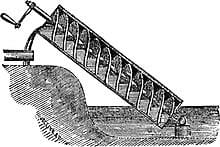
“When… the Romans assaulted the walls in two places at once, fear and consternation stupefied the Syracusans…. But when Archimedes began to ply his engines, he at once shot against the land forces all sorts of missile weapons… that came down with incredible noise and violence… they knocked down those upon whom they fell in heaps, breaking all their ranks and files.”
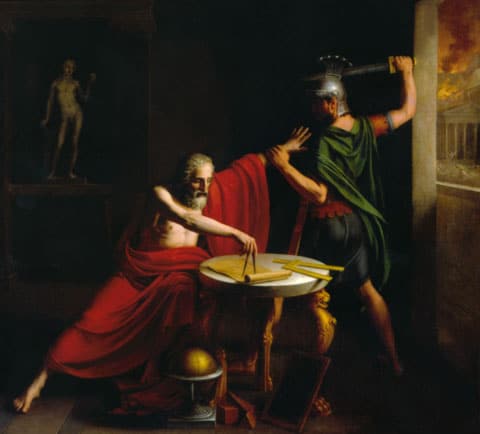
He was buried in Syracuse with a model sculpture of his sphere and cylinder. The tomb of Archimedes was later rediscovered by Cicero in about 75BC.
Influence of Archimedes
Archimedes was in many ways ahead of his time. Despite numerous breakthroughs in mathematics, there was not sufficient skilled and intelligent mathematicians to make use and develop Archimedes work in the classical period.
“Modern mathematics was born with Archimedes and died with him for all of two thousand years. It came to life again with Descartes and Newton.”
Eric Temple Bell, The Development of Mathematics (1940)
Many of his works were lost or fell out of general circulation. However, some works were preserved and when they were rediscovered and re-printed, they gave a major boost to a reinvigoration of mathematics in Asia and Europe. Archimedes works were translated into Arabic in the 9th Century AD. In 1544, a version of Archimedes works in both Latin and Greek were published in Editio Princeps in Basel. This was a very influential work. Galileo was a great admirer of Archimedes and – influenced by his writings, he invented a hydrostatic balance for weighing metals in water and air. Perhaps even more important was Archimedes influence on mathematicians Rene Descartes and Pascal Blaise. In 1906, the Archimedes Palimpsest was discovered – and, although overwritten with prayers in the 13th Century, underneath they discovered original writings of Archimedes that had been first written in the 10th Century AD. It includes original sources of On Floating Bodies and “The Method of Mechanical Theorems.”
Citation: Pettinger, Tejvan . “Biography of Archimedes”, Oxford, UK www.biographyonline.net Published 8 July 2019.

Archimedes at Amazon
Related pages

MacTutor
Archimedes of syracuse.
... so that those who claim to discover everything, but produce no proofs of the same, may be confuted as having pretended to discover the impossible.
Archimedes ... in writing to King Hiero, whose friend and near relation he was....
... when Archimedes began to ply his engines, he at once shot against the land forces all sorts of missile weapons, and immense masses of stone that came down with incredible noise and violence; against which no man could stand; for they knocked down those upon whom they fell in heaps, breaking all their ranks and files. In the meantime huge poles thrust out from the walls over the ships and sunk some by great weights which they let down from on high upon them; others they lifted up into the air by an iron hand or beak like a crane's beak and, when they had drawn them up by the prow, and set them on end upon the poop, they plunged them to the bottom of the sea; or else the ships, drawn by engines within, and whirled about, were dashed against steep rocks that stood jutting out under the walls, with great destruction of the soldiers that were aboard them. A ship was frequently lifted up to a great height in the air ( a dreadful thing to behold ) , and was rolled to and fro, and kept swinging, until the mariners were all thrown out, when at length it was dashed against the rocks, or let fall.
These machines [ Archimedes ] had designed and contrived, not as matters of any importance, but as mere amusements in geometry; in compliance with King Hiero's desire and request, some little time before, that he should reduce to practice some part of his admirable speculation in science, and by accommodating the theoretic truth to sensation and ordinary use, bring it more within the appreciation of the people in general.
[ Archimedes ] had stated [ in a letter to King Hieron ] that given the force, any given weight might be moved, and even boasted, we are told, relying on the strength of demonstration, that if there were another earth, by going into it he could remove this. Hiero being struck with amazement at this, and entreating him to make good this problem by actual experiment, and show some great weight moved by a small engine, he fixed accordingly upon a ship of burden out of the king's arsenal, which could not be drawn out of the dock without great labour and many men; and, loading her with many passengers and a full freight, sitting himself the while far off, with no great endeavour, but only holding the head of the pulley in his hand and drawing the cords by degrees, he drew the ship in a straight line, as smoothly and evenly as if she had been in the sea.
Archimedes possessed so high a spirit, so profound a soul, and such treasures of scientific knowledge, that though these inventions had now obtained him the renown of more than human sagacity, he yet would not deign to leave behind him any commentary or writing on such subjects; but, repudiating as sordid and ignoble the whole trade of engineering, and every sort of art that lends itself to mere use and profit, he placed his whole affection and ambition in those purer speculations where there can be no reference to the vulgar needs of life; studies, the superiority of which to all others is unquestioned, and in which the only doubt can be whether the beauty and grandeur of the subjects examined, of the precision and cogency of the methods and means of proof, most deserve our admiration.
Oftimes Archimedes' servants got him against his will to the baths, to wash and anoint him, and yet being there, he would ever be drawing out of the geometrical figures, even in the very embers of the chimney. And while they were anointing of him with oils and sweet savours, with his fingers he drew lines upon his naked body, so far was he taken from himself, and brought into ecstasy or trance, with the delight he had in the study of geometry.
... gave birth to the calculus of the infinite conceived and brought to perfection by Kepler , Cavalieri , Fermat , Leibniz and Newton .
...a theory of the distances of the heavenly bodies ascribed to Archimedes, but the corrupt state of the numerals in the sole surviving manuscript [ due to Hippolytus of Rome, about 220 AD ] means that the material is difficult to handle.
... certain things first became clear to me by a mechanical method, although they had to be proved by geometry afterwards because their investigation by the said method did not furnish an actual proof. But it is of course easier, when we have previously acquired, by the method, some knowledge of the questions, to supply the proof than it is to find it without any previous knowledge.
It is not possible to find in all geometry more difficult and intricate questions, or more simple and lucid explanations. Some ascribe this to his natural genius; while others think that incredible effort and toil produced these, to all appearances, easy and unlaboured results. No amount of investigation of yours would succeed in attaining the proof, and yet, once seen, you immediately believe you would have discovered it; by so smooth and so rapid a path he leads you to the conclusion required.
The treatises are, without exception, monuments of mathematical exposition; the gradual revelation of the plan of attack, the masterly ordering of the propositions, the stern elimination of everything not immediately relevant to the purpose, the finish of the whole, are so impressive in their perfection as to create a feeling akin to awe in the mind of the reader.
Archimedes ... was ..., as fate would have it, intent upon working out some problem by a diagram, and having fixed his mind alike and his eyes upon the subject of his speculation, he never noticed the incursion of the Romans, nor that the city was taken. In this transport of study and contemplation, a soldier, unexpectedly coming up to him, commanded him to follow to Marcellus; which he declining to do before he had worked out his problem to a demonstration, the soldier, enraged, drew his sword and ran him through.
... a Roman soldier, running upon him with a drawn sword, offered to kill him; and that Archimedes, looking back, earnestly besought him to hold his hand a little while, that he might not leave what he was then at work upon inconclusive and imperfect; but the soldier, nothing moved by his entreaty, instantly killed him.
... as Archimedes was carrying to Marcellus mathematical instruments, dials, spheres, and angles, by which the magnitude of the sun might be measured to the sight, some soldiers seeing him, and thinking that he carried gold in a vessel, slew him.
... and found it enclosed all around and covered with brambles and thickets; for I remembered certain doggerel lines inscribed, as I had heard, upon his tomb, which stated that a sphere along with a cylinder had been put on top of his grave. Accordingly, after taking a good look all around ..., I noticed a small column arising a little above the bushes, on which there was a figure of a sphere and a cylinder... . Slaves were sent in with sickles ... and when a passage to the place was opened we approached the pedestal in front of us; the epigram was traceable with about half of the lines legible, as the latter portion was worn away.
Unlike the Elements of Euclid , the works of Archimedes were not widely known in antiquity. ... It is true that ... individual works of Archimedes were obviously studied at Alexandria, since Archimedes was often quoted by three eminent mathematicians of Alexandria: Heron , Pappus and Theon .
References ( show )
- M Clagett, Biography in Dictionary of Scientific Biography ( New York 1970 - 1990) . See THIS LINK .
- Biography in Encyclopaedia Britannica. http://www.britannica.com/biography/Archimedes
- A Aaboe, Episodes from the early history of mathematics ( Washington, D.C., 1964) .
- R S Brumbaugh, The philosophers of Greece ( Albany, N.Y., 1981) .
- H Bernhard, Archimedes, in H Wussing and W Arnold, Biographien bedeutender Mathematiker ( Berlin, 1983) .
- E J Dijksterhuis, Archimedes ( Copenhagen, 1956 and Princeton, NJ, 1987) .
- T L Heath, A history of Greek mathematics II ( Oxford, 1931) .
- J Hjelmslev, Über Archimedes' Grössenlehre, Danske Vid. Selsk. Mat.-Fys. Medd. 25 (15) (1950) .
- W R Knorr, Archimedes and the pseudo-Euclidean 'Catoptrics' : early stages in the ancient geometric theory of mirrors, Arch. Internat. Hist. Sci. 35 (114 - 115) (1985) , 28 - 105 (1986) .
- S Ya Lur'e, Archimedes ( Russian ) ( Moscow-Leningrad, 1945) .
- E Rufini, Il 'metodo' di Archimede e le origini del calcolo infinitesimale nell'antichità ( Milan, 1961) .
- I Schneider, Archimedes : Ingenieur, Naturwissenschaftler und Mathematiker ( Darmstadt, 1979) .
- E S Stamatis, The burning mirror of Archimedes ( Greek ) ( Athens, 1982) .
- A Aaboe and J L Berggren, Didactical and other remarks on some theorems of Archimedes and infinitesimals, Centaurus 38 (4) (1996) , 295 - 316 .
- A R Amir-Moéz, Khayyam, al-Biruni, Gauss, Archimedes, and quartic equations, Texas J. Sci. 46 (3) (1994) , 241 - 257 .
- M Authier, Archimède : le canon du savant,in Eléments d'histoire des sciences ( Paris, 1989) , 101 - 127 .
- I G Basmakova, Differential methods in the works of Archimedes ( Russian ) , Istor.-Mat. Issled. 6 (1953) , 609 - 658 .
- H G Beisenherz, Archimedes und die Protophysik, Philos. Natur. 18 (4) (1980 / 81) , 438 - 478 .
- J L Berggren, Archimedes among the Ottomans, in From ancient omens to statistical mechanics, Acta Hist. Sci. Nat. Med. 39 ( Copenhagen, 1987) , 101 - 109 .
- J L Berggren, A lacuna in Book T of Archimedes' 'Sphere and cylinder', Historia Math. 4 (1977) , 1 - 5 .
- J L Berggren, Spurious theorems in Archimedes' Equilibrium of planes. Book I, Arch. History Exact Sci. 16 (2) (1976 / 77) , 87 - 103 .
- M G Beumer, Archimedes and the trisection of the angle ( Dutch ) , Nieuw Tijdschr. Wiskunde 33 (1946) , 281 - 287 .
- S E Brodie, Archimedes' axioms for arc-length and area, Math. Mag. 53 (1) (1980) , 36 - 39 .
- P Delsedime, Uno strumento astronomico descritto nel corpus Archimedeo : la dioptra di Archimede, Physis - Riv. Internaz. Storia Sci. 12 (2) (1970) , 173 - 196 .
- G Derenzini, L'eliocentrismo di Aristarco da Archimede a Copernico, Physis - Riv. Internaz. Storia Sci. 16 (4) (1974) , 289 - 308 .
- E J Dijksterhuis, Die Integrationsmethoden von Archimedes, Nordisk Mat. Tidskr. 2 (1954) , 5 - 23 .
- Y Dold-Samplonius, Archimedes : Einander berührende Kreise, Sudhoffs Arch. 57 (1973) , 15 - 40 .
- A G Drachmann, Archimedes and the science of physics, Centaurus 12 (1967 / 1968) , 1 - 11 .
- A G Drachmann, Fragments from Archimedes in Heron's Mechanics, Centaurus 8 (1963) , 91 - 146 .
- D C Gazis and R Herman, Square roots geometry and Archimedes, Scripta Math. 25 (1960) , 228 - 241 .
- G Giorello, Archimede e la metodologia dei programmi di ricerca ( Italian : With an English translation ) , Scientia ( Milano ) 110 (1 - 4) (1975) , 111 - 135 .
- G Goe, Is Archimedes' proof of the principle of the lever fallacious?, in 1971 Actes XIIe Congrès Internat. d'Histoire des Sciences Tome IV : Histoire des Mathématiques et de la Mécanique ( Paris, 1968) , 73 - 77 .
- A Guzzo, Archimede ( Italian ) , Filosofia 3 (1952) , 149 - 168 .
- E Hayashi, A reconstruction of the proof of Proposition 11 in Archimedes's method : proofs about the volume and the center of the gravity of any segment of an obtuse-angled conoid, Historia Sci. (2) 3 (3) (1994) , 215 - 230 .
- H Hermelink, Ein bisher übersehener Fehler in einem Beweis des Archimedes, Arch. Internat. Hist. Sci. ( N.S. ) 6 (1953) , 430 - 433 .
- M C Hernández Martin, Sketch of an internal logic in the works of Archimedes ( Spanish ) , Arch. Hist. Exact Sci. 46 (2) (1993) , 139 - 151 .
- D L Hilliker, A study in the history of analysis up to the time of Leibniz and Newton in regard to Newton's discovery of the binomial theorem II : Contributions of Archimedes, Math. Student 42 (1974) , 107 - 110 .
- J Hjelmslev, Eudoxus' axiom and Archimedes' lemma, Centaurus 1 (1950) , 2 - 11 .
- J E Hofmann, Über Archimedes' halbregelmässige Körper, Arch. Math. 14 (1963) , 212 - 216 .
- S H Hollingdale, Archimedes of Syracuse : a tribute on the 22 nd century of his death, Bulletin Institute of Mathematics and its Applications 25 (9) (1989) , 217 - 225 .
- S H Hollingdale, Archimedes of Syracuse : a tribute on the 22 nd centenary of his death, Bull. Inst. Math. Appl. 25 (9) (1989) , 217 - 225 .
- J Itard, Quelques remarques sur les méthodes infinitésimales chez Euclide et Archimède, Rev. Hist. Sci. Appl. 3 (1950) , 210 - 213 .
- W R Knorr, On an alleged error in Archimedes' 'Conoids'. Prop. 1 , Historia Math. 20 (2) (1993) , 193 - 197 .
- W R Knorr, On Archimedes' construction of the regular heptagon, Centaurus 32 (4) (1989) , 257 - 271 .
- W R Knorr, Archimedes' 'Dimension of the circle' : a view of the genesis of the extant text, Arch. Hist. Exact Sci. 35 (4) (1986) , 281 - 324 .
- W R Knorr, Archimedes and the pre-Euclidean proportion theory, Arch. Internat. Hist. Sci. 28 (103) (1978) , 183 - 244 .
- W R Knorr, Archimedes and the 'Elements' : proposal for a revised chronological ordering of the Archimedean corpus, Arch. Hist. Exact Sci. 19 (3) (1978 / 79) , 211 - 290 .
- W R Knorr, Archimedes and the spirals : the heuristic background, Historia Math. 5 (1) (1978) , 43 - 75 .
- W Knorr, Archimedes' lost treatise on the centers of gravity of solids, Math. Intelligencer 1 (2) (1978 / 79) , 102 - 109 .
- W R Knorr, Archimedes and the measurement of the circle : a new interpretation, Arch. History Exact Sci. 15 (2) (1975 / 76) , 115 - 140 .
- W R Knorr, Archimedes' neusis-constructions in spiral lines, Centaurus 22 (2) (1978 / 79) , 77 - 98 .
- G M Kozhukhova, The Arabic version of Archimedes' 'Measurement of a circle' ( Russian ) , Istor.-Mat. Issled. 25 (1980) , 315 - 316 , 380 .
- B I Kozlov, Archimedes and the genesis of technological knowledge ( Russian ) , Voprosy Istor. Estestvoznan. i Tekhn. (3) (1984) , 18 - 32 .
- E Kreyszig, Archimedes and the invention of burning mirrors : an investigation of work by Buffon, in Geometry, analysis and mechanics ( River Edge, NJ, 1994) , 139 - 148 .
- W R Laird, Archimedes among the humanists, Isis 82 (314) (1991) , 629 - 638 .
- L H Lange, Hommage à Archimède, Fibonacci Quart. 19 (3) (1981) , 214 - 219 .
- S Maracchia, Una progressione geometrica in Archimede ( Italian ) , Archimede 25 (1973) , 314 - 317 .
- O Neugebauer, Archimedes and Aristarchus, Isis 34 (1942) , 4 - 6 .
- C Osborne, Archimedes on the Dimension of the Cosmos, Isis 74 (272) (1983) , 234 - 242 .
- C Pereira da Silva, On Archimedes of Syracuse ( Portuguese ) , Bol. Soc. Paran. Mat. (2) 8 (1) (1987) , 51 - 68 .
- J H Pérez, The method of Archimedes ( Spanish ) , Bol. Mat. 17 (1 - 3) (1983) , 118 - 139 .
- G M Phillips, Archimedes the numerical analyst, Amer. Math. Monthly 88 (3) (1981) , 165 - 169 .
- J M Rassias, Archimedes, in Geometry, analysis and mechanics ( River Edge, NJ, 1994) , 1 - 4 .
- T S Sarangov, Archimedes' proof of the lever principle ( Russian ) , in History and methodology of the natural sciences XXXI ( Moscow, 1985) , 89 - 101 .
- T Sato, A reconstruction of 'The Method' Proposition 17 , and the development of Archimdedes' thought on quadrature. Why did Archimedes not notice the internal connection in the problems dealt with in many of his works? II, Japan. Stud. Hist. Sci. 32 (1987) , 75 - 142 .
- T Sato, A reconstruction of 'The method' Proposition 17 , and the development of Archimedes' thought on quadrature. Why did Archimedes not notice the internal connection in the problems dealt with in many of his works? I, Japan. Stud. Hist. Sci. 31 (1986) , 61 - 86 .
- T Sato, Archimedes' lost works on the centers of gravity of solids, plane figures and magnitudes, Japan. Stud. Hist. Sci. 20 (1981) , 1 - 41 .
- T Sato, Archimedes' 'On the measurement of a circle', Proposition 1 : an attempt at reconstruction, Japan. Stud. Hist. Sci. 18 (1979) , 83 - 99 .
- J J Schäffer, The scientific personality of Archimedes ( Spanish ) , Fac. Ingen. Agrimens. Montevideo. Publ. Didact. Inst. Mat. Estadist. 1 (1958) , 57 - 93 .
- P Schreiber, A note on the cattle problem of Archimedes, Historia Math. 20 (3) (1993) , 304 - 306 .
- P Schultz, Tartaglia, Archimedes and cubic equations, Austral. Math. Soc. Gaz. 11 (4) (1984) , 81 - 84 .
- A E Shapiro, Archimedes's measurement of the sun's apparent diameter, J. Hist. Astronom. 6 (1975) , 75 - 83 .
- D L Simms, Archimedes' weapons of war and Leonardo, British J. Hist. Sci. 21 (69 , 2) (1988) , 195 - 210 .
- E S Stamatis, Reconstruction of the ancient text in the Sicilian Doric dialect of fifteen theorems of Archimedes which are preserved in the Arabic language ( Greek ) , Bull. Soc. Math. Grèce ( N.S. ) 6 II (1965) , 265 - 297 .
- C M Taisbak, Analysis of the so-called 'lemma of Archimedes' for constructing a regular heptagon, Centaurus 36 (3 - 4) (1993) , 191 - 199 .
- J G Thompson, Archimedes and continued fractions, Math. Medley 15 (2) (1987) , 67 - 75 .
- G Vacca, Sugli specchi ustori di Archimede, Boll. Un. Mat. Ital. (2) 3 (1940) , 71 - 73 .
- R von Erhardt and E von Erhardt, Archimedes' Sand-Reckoner, Isis 34 (1943) , 214 - 215 .
- W C Waterhouse, On the cattle problem of Archimedes, Historia Math. 22 (2) (1995) , 186 - 187 .
- A P Yushkevich, On the first Russian editions of the works of Euclid and Archimedes ( Russian ) , Akad. Nauk SSSR. Trudy Inst. Istorii Estestvoznaniya 2 (1948) , 567 - 572 .
- S V Zitomirskii, The 'celestial globe' of Archimedes ( Russian ) , Istor.-Astronom. Issled. 14 (1978) , 271 - 302 .
- S V Zitomirskii, The astronomical works of Archimedes ( Russian ) , Istor.-Astronom. Issled. Vyp. 13 (1977) , 319 - 337 .
Additional Resources ( show )
Other pages about Archimedes:
- See Archimedes on a timeline
- Archimedean solids
- Archimedes on mechanical and geometric methods
- Archimedes' Quadrature of the parabola
- Archimedes on statics
- The Archimedean cattle problem
- Semi-regular ( or Archimedean ) solids
- Cremona's translation of On the Sphere and Cylinder (1544)
- Herbert Jennings Rose's Greek mathematical literature
- Miller's postage stamps
- Heinz Klaus Strick biography
Other websites about Archimedes:
- Dictionary of Scientific Biography
- Encyclopaedia Britannica
- G M Philips ( Archimedes' calculation of π )
- University of Waterloo ( The Sandreckoner )
- Science Museum Florence
- Vatican exhibition,
- G Don Allen
- Kevin Brown ( Some information about Archimedes' calculation of square roots )
- Kevin Brown ( On spheres and cylinders )
- MIT ( Plutarch's account of Archimedes' war machines and of his death )
- Peter Alfeld
- Caltech exhibition
- Google books
- MathSciNet Author profile
Honours ( show )
Honours awarded to Archimedes
- Lunar features Crater Archimedes and Rimae Archimedes and Montes Archimedes
- Popular biographies list Number 6
Cross-references ( show )
- History Topics: A chronology of π
- History Topics: A history of Pi
- History Topics: A history of Topology
- History Topics: A history of the calculus
- History Topics: An overview of Indian mathematics
- History Topics: Arabic mathematics : forgotten brilliance?
- History Topics: Archimedes: Numerical Analyst
- History Topics: Doubling the cube
- History Topics: Greek astronomy
- History Topics: Greek number systems
- History Topics: How do we know about Greek mathematicians?
- History Topics: How do we know about Greek mathematics?
- History Topics: Indian numerals
- History Topics: Infinity
- History Topics: Mathematical games and recreations
- History Topics: Mathematics and the physical world
- History Topics: Pell's equation
- History Topics: Squaring the circle
- History Topics: Trisecting an angle
- Famous Curves: Cissoid of Diocles
- Famous Curves: Hyperbolic Spiral
- Famous Curves: Involute of a Circle
- Famous Curves: Spiral of Archimedes
- Other: 1928 ICM - Bologna
- Other: 2009 Most popular biographies
- Other: Earliest Known Uses of Some of the Words of Mathematics (A)
- Other: Earliest Known Uses of Some of the Words of Mathematics (H)
- Other: Earliest Known Uses of Some of the Words of Mathematics (M)
- Other: Earliest Known Uses of Some of the Words of Mathematics (P)
- Other: Earliest Known Uses of Some of the Words of Mathematics (R)
- Other: Jeff Miller's postage stamps
- Other: London Learned Societies
- Other: London Scientific Institutions
- Other: London individuals N-R
- Other: Most popular biographies – 2024
- Other: Other London Institutions outside the centre
- Other: Popular biographies 2018
Meet Archimedes of Syracuse: The Mathematician Who Discovered Pi and Designed War Machines
The Greek’s calculation of the infinite mathematical concept pi in the 200s BCE is celebrated every year on March 14, or Pi Day.
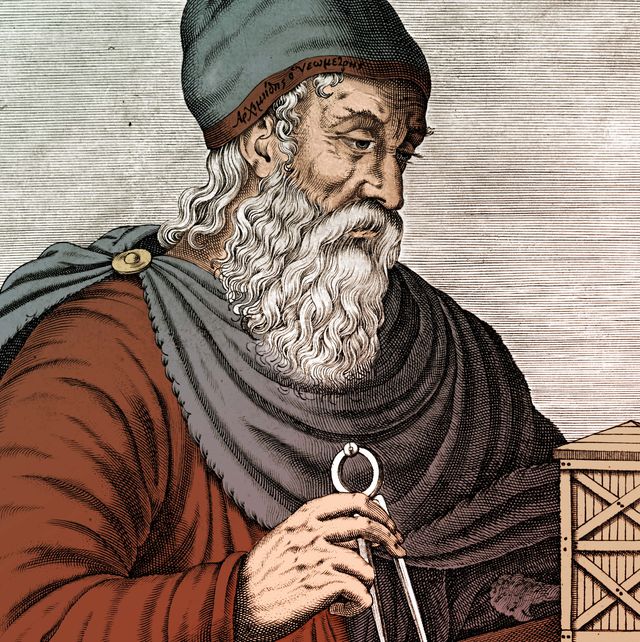
It’s the most wonderful time of the year—for mathematicians, anyway.
Pi Day is Thursday, March 14. The relatively new holiday is a celebration of the mathematical calculation pi, or the infinite number representing the constant ratio of a circle’s circumference to its diameter. Pi is essential to engineering and modern construction.
Although many sought to find it, the calculation of pi, which is also expressed by the fraction 22/7, is commonly credited to Greek mathematician Archimedes of Syracuse more than 2,200 years ago.
The first Pi Day took place at the Exploratorium, a San Francisco–based science museum, and featured a circular parade and fruit pies. The latter has become a delicious tradition among academic and office settings. In 2009, the U.S. House of Representatives passed a resolution recognizing March 14 as National Pi Day.
According to the Exploratorium , mathematicians began using π, the Greek letter pi, for the calculation’s symbol in the 1700s, starting with William Jones in 1706. Leonhard Euler subsequently popularized the symbol.
As for Archimedes, you might be surprised to learn that pi was just one of his many important discoveries and inventions.
Who Was Archimedes?
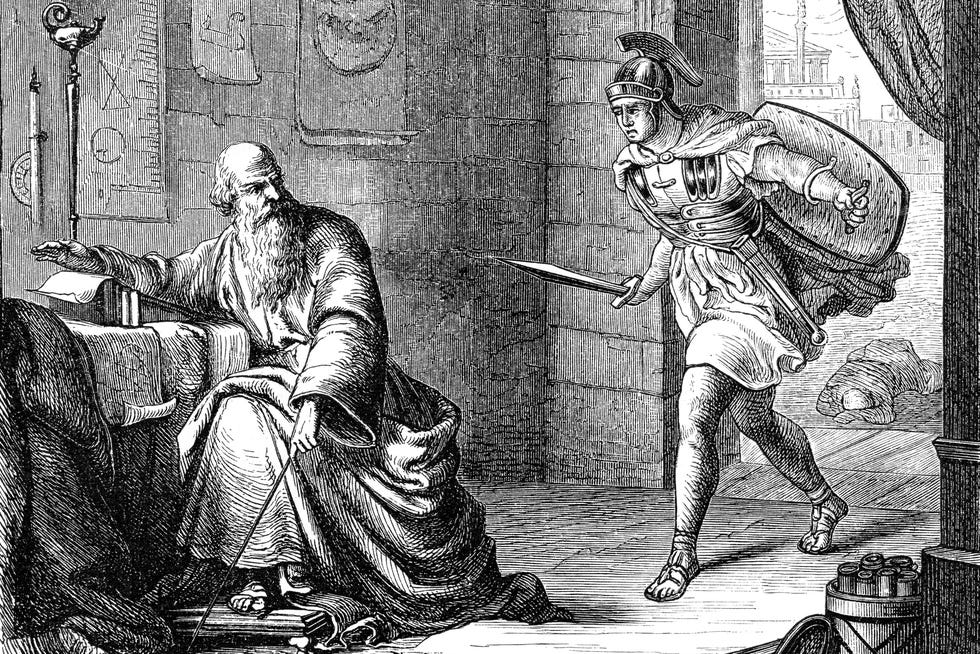
According to NOVA , Archimedes was born in Syracuse—on the Mediterranean island of Sicily, not upstate New York—around 287 BCE. He was the son of astronomer Phidias and a close ally of Syracuse’s King Hieron and his son, whom he served many years.
Archimedes traveled to Egypt to study at the Library of Alexandria at age 18 and, upon completing his work, returned to Syracuse around 263 BCE for the remainder of his life.
Over roughly the next 50 years, Archimedes developed most of his major theories. These included the fundamental principles of mechanics; methods for finding the center of gravity, surface area, and volume of geometric figures; the principle of buoyancy; and, of course, an estimate for the value of pi.
Archimedes was obsessed with math, often getting lost in his work and forgetting to eat. Legend has it he discovered his principle of buoyancy while taking a bath. Excited, he leapt out of the tub and ran naked through the streets of Syracuse shouting, “Eureka!”
By one account , Greek philosopher Plutarch reported that Archimedes died while solving a math problem. In 212 BCE, during the Second Punic War, a Roman solider asked Archimedes to accompany him amid a siege of Syracuse. Archimedes refused, and the angry soldier stabbed him with a sword.
What Else Did Archimedes Do?
Archimedes is often credited with inventing the Archimedes’ screw, a device for raising water, while in Egypt. The large helix is encased lengthwise in a watertight covering with openings at both ends. When one end is placed in water and the device is elevated at an angle and turned, water trapped in air pockets rises from the lower end through the open upper end.
Back then, it was used to pump water out of ships and for irrigation. But the design is still used today. According to Scientific American , modern examples include lifting wastewater in treatment plants and even lifting water for some amusement park rides.
Archimedes also created a means for approximating square roots and devised ways of calculating area and volume two millennia before the invention of calculus.
When the Romans invaded Syracuse, Archimedes’ “engines of war” helped defend the city. These devices included cranes to drop rocks, claws to lift ships from the water, and machines to fire wooden missiles. He also devised a set of mirrors that focused sunlight on enemy ships, setting them on fire.
Finally, Archimedes proved the volume of a sphere is two-thirds the volume of a circumscribed cylinder. He considered this his greatest accomplishment and asked that a representation of a sphere inside a cylinder be left on his tomb. He is likely buried in Sicily.
Tracing Archimedes’ Legacy
According to NOVA , scribes copied Archimedes’ writings onto parchment in 300 AD. His manuscript explaining how he developed his mathematical theorems was copied and bound onto vellum sheets around 1000. Archimedes’ treatise Measurement of a Circle — which helped spread his process for calculating pi around the world, according to the American Mathematical Society —was part of this manuscript.
Around 200 years later, a monk reused the manuscript to make a prayer book. Finished in 1229 and likely made in Jerusalem, this manuscript became known as the Archimedes Palimpsest. It is the only surviving copy of Archimedes’ manuscript and contains several of his treatises.
For about 400 years, the Palimpsest was stored in a monastery in the Judean desert before being moved to a library in Old Jerusalem. German scholar Constantine Tischendorf discovered it in Constantinople in 1846, and Danish scholar Johan Ludwig attempted to transcribe it in 1906 using a magnifying glass.
Shockingly, the Palimpsest disappeared for much of the 20 th century. It resurfaced in a damaged state in Paris in 1998 and was sold at auction for $2 million to an anonymous American collector. The buyer then donated the book to the Walters Art Museum in Baltimore in 1999. It was featured there in a 2011 exhibit titled “Lost & Found: The Secrets of Archimedes.”
Tyler Piccotti first joined the Biography.com staff as an Associate News Editor in February 2023, and before that worked almost eight years as a newspaper reporter and copy editor. He is a graduate of Syracuse University. When he's not writing and researching his next story, you can find him at the nearest amusement park, catching the latest movie, or cheering on his favorite sports teams.
Famous Mathematicians

Benjamin Banneker

22 Famous Scientists You Should Know
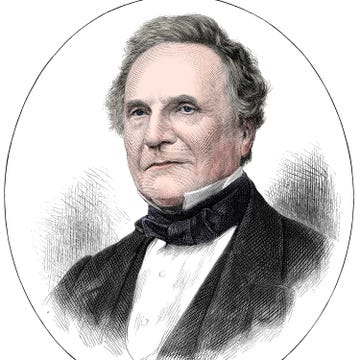
Charles Babbage
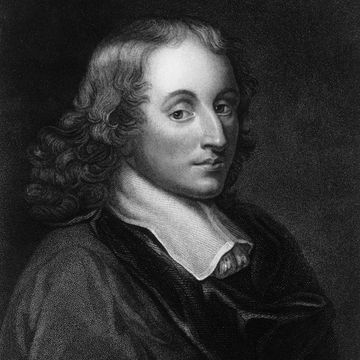
Blaise Pascal

Leonhard Euler

Ada Lovelace

Valerie Thomas
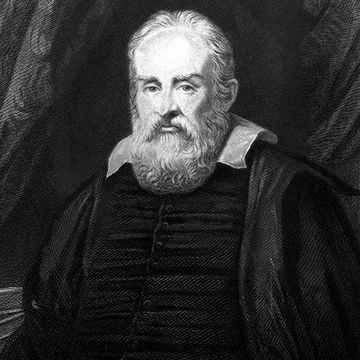
Mary Jackson
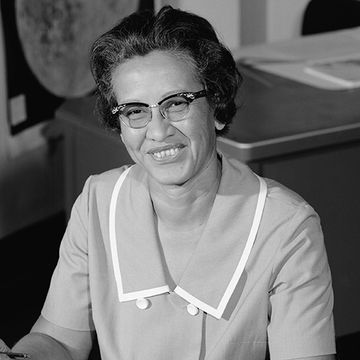
Katherine Johnson
- Scientific Methods
- Famous Physicists
Archimedes was perhaps one of the most outstanding scientists in the world. Indeed, a supreme scientist of the classical age, Archimedes was a mathematician, physicist, engineer, astronomer, weapons designer, and inventor. Archimedes is one of the great thinkers in history. He was wise in philosophy, active in mathematics and physics and was also recognized as one of the finest engineers of his time. Through historical accounts of his uncountable inventions and discoveries, he left his legacy 2000 years ago.
Table of Contents
About archimedes.
- Archimedes’ Greatest Achievements
Archimedes’ Principle
Archimedes’ screw, the odometer, archimedes’ law of lever.
- Frequently Asked Questions – FAQs
Archimedes was born in C. 287 BCE, in Syracuse, Sicily (Italy), and is regarded as the most well-known mathematician and inventor in ancient Greece. Archimedes will always be remembered for his significant discovery; that is, he successfully determined the relation between the surface and volume of a sphere and its circumscribing cylinder. Archimedes also formulated the hydrostatic principle known as Archimedes’ Principle, which states that an upward force equal to the weight of the fluid displaced, is acted on a body when placed in a liquid. And also, Archimedes invented a screw for raising water which is still considered the most important invention.
Also, Archimedes studied different aspects of the lever and pulley. A lever is a kind of elementary machine in which a bar is used to move or raise a weight, while a pulley uses a rope, wheel or chain to lift loads. He also discovered the law of buoyancy .

Archimedes Greatest Achievements
Some of the most outstanding achievements of Archimedes are listed below –
- Archimedes invented the crucial sciences of mechanics and hydrostatics.
- Archimedes created one of the essential physics concepts that is the centre of gravity.
- He discovered the laws of levers and pulleys that allow moving heavy objects using small forces.
- Archimedes calculated the most precise value of pi. The fraction 22⁄7 was his upper limit of pi; this value is still in use.
- Archimedes also discovered mathematically verified formulas for the volume and surface area of a sphere.
- How exponents could be used to write more significant numbers was shown by Archimedes.
Archimedes was the one who discovered the principle of buoyancy, also known as Archimedes’ Principle , which states that an upward or buoyant force is acted upon a body upwards when it is wholly or partially submerged in a fluid at rest and that the magnitude of this force is equivalent to the weight of the fluid displaced by the body.
The story behind it is that the King assigned Archimedes a task to figure out whether the crown made for him was pure gold or it contained some other metals too; this caused him to discover the famous Archimedes’ principle. He took a lump of gold weighing the same as the gold crown, and regardless of their shapes, these two objects should displace the same amount of water. The crown would replace more water if the goldsmith who made the crown substituted any gold with a cheaper metal.
Concept visualised | Archimedes’ principle – Mechanical Properties of Fluids | Concept visualised | Archimedes’ principle | NEET

Archimedes’ Screw is a device that was rotated by a windmill or through manual labour; it is a screw-shaped device that lifts the water inside the spiral tube to a higher elevation as the entire unit is rotated. The design of this device was beneficial, especially to the farmers, and it was even carried out in other industries to move light ingredients like grain in and out of farming silos.
Archimedes was also the first who came up with an idea of an odometer; it is a mechanical method of keeping track of distance travelled.
The idea behind the working of the Odometer was that a wheel travels its own circumference every time it goes around. He mounted a giant wheel of known circumference in a small frame. With each revolution, it repeatedly released a pebble into a container giving a measure of the distance travelled. In effect, it was the first Odometer.
Archimedes also found new usages for the lever. It was once said by the great inventor, “Give me a place to stand on, and a lever long enough, and I will move the earth.” He proved this statement by illustrating it with a considerable mechanism of a lever, along with a sequence of pulleys to launch the newly-constructed ship. Archimedes precisely described fundamental physics and clarified the ratios of force, load, and the lever’s capability.
For more such interesting articles, stay tuned to BYJU’S. Also, register to “BYJU’S – The Learning App” for loads of interactive, engaging Physics-related videos and an unlimited academic assist.
Frequently Asked Questions
What is buoyant force.
The buoyant force is an upward force exerted by a fluid that opposes the weight of a fully or partially immersed body.
What is the use of an Odometer?
It is a device used to measure the distance travelled by a vehicle.
What is Archimedes’ famous invention?
Archimedes’ Screw is the most famous Archimedes invention.
Explain Archimedes’ Principle.
An upward or buoyant force is acted upon a body upwards when it is wholly or partially submerged in a fluid at rest, and the magnitude of this force is equivalent to the weight of the fluid displaced by the body.
What is Archimedes’ Screw?
Archimedes’ screw is an invention that is used to lift the water at a higher elevation.
Leave a Comment Cancel reply
Your Mobile number and Email id will not be published. Required fields are marked *
Request OTP on Voice Call
Post My Comment
- Share Share

Register with BYJU'S & Download Free PDFs
Register with byju's & watch live videos.

Though his exploits in the field of geometry, science, and physics are widely famous, not much is known about his personal life, as all records have been lost. He was so much in love with geometry and his inventions that the last words he uttered were "Do not disturb my circles."
He was killed in the Second Punic War by a Roman soldier against the wishes of General Marcellus. Plutarch writes that Archimedes was contemplating a mathematical diagram at the time of his death. His tomb was engraved with the figure of a sphere and cylinder as per his wish.
In the field of mathematics, Archimedes produced several theorems that became widely known throughout the world. He is credited with producing some of the principles of calculus long before Newton and Leibniz. He worked out ways of squaring the circle and computing areas of several curved regions. His interest in mechanics is credited with influencing his mathematical reasoning, which he used in devising new mathematical theorems. He proved that the surface area and volume of a sphere are two-thirds that of its circumscribing cylinder.
He is credited with the invention of Archimedes screw or screw pump, which is a device used to raise the level of water from a lower area to a higher elevation. He is known for the formulation of Archimedes' principle, a hydrostatic principle stating that an object in any liquid is buoyed by force equal to the weight of fluid it displaces. Legend has it that he discovered the principle of buoyancy while taking bath and following the discovery, he ran naked shouting "Eureka, Eureka," meaning I have found it.
Using the method of exhaustion, he was able to address irrational numbers, such as square roots and Pi. He showed how to calculate areas and tangents. His mastery of applied mathematics reflects from his work on the Archimedes screw.
From his invention of war machines, such as parabolic mirrors, Archimedes claw and death ray and complex lever systems, shows that he played an important role in guarding Syracuse against the siege laid by Romans. Though he could not save Syracuse from being captured by General Marcus Claudius Marcellus and his Roman forces in 212 B.C., his war machines might have delayed the capture. Archimedes himself was killed when the city was captured by the Romans.
Undoubtedly, Archimedes was one of the most brilliant minds of all times. His contributions in the field of geometry, science, and physics truly reflect his genius. He wrote many treatises, but only a few would survive the Middle Ages. Still his work and fame live on.
Rumor Has It …
Archimedes was caught read handed, by his wife, wearing a chicken hat on April Fool's Day inside a chicken coop pecking at some grain yet laughing like a duck.
Written by Kevin Lepton
Claimed by Scott Shaeffer (Shaeffernew)
Archimedes was a great "Renaissance Man" even though he was not in the Renaissance. He invented many outstanding machines that were practical in their time and some that seemed a little out there. Archimedes also led the way for areas of physics such as in the field of buoyancy and hydrostatics. He was also a brilliant mathematician and could accurately give the answer to the square root of 3 to a good amount of decimal place accuracy even though his explanation for how he did it is mysterious and a little foggy. Archimedes is a notable scientist and deserves recognition for his work.
- 1.1 The Life of Archimedes
- 2.1 Archimedes' Principle
- 2.2 Inventions
- 3.1 Further reading
- 3.2 External links
- 4 References
Personal Life
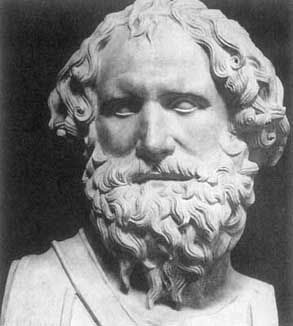
The Life of Archimedes
Archimedes was born in Syracuse in 287 BC with Phidias as his father. The mother is not known. Archimedes was a famous Greek mathematician, engineer, inventor, physicist, and renowned thinker and problem solver. He laid the foundations for many prominent fields of physics and math such as hydrostatics and buoyancy. Not much is known about his earlier life and childhood due to absent records and historical mysteries, but we know assumptions about his earlier life. Specifically, only a handful of his personal works lasted through the Middle Ages [2] and this is what caused him to become such an influential scientist and inventor. Also, one of the few things researchers and historians can agree on is that Archimedes began his studies in a school run by Euclid (a Greek mathematician) in Alexandria, Egypt [2]. These are just the few personal things we know about Archimedes, but we know a lot more from his works and inventions. Archimedes died in 212 BC at around 75 years old in Syracuse, Sicily [3].
Scientific Contributions
Archimedes' principle.
Archimedes discovered how to find the volume of an irregularly shaped object by submerging it in a liquid and measuring the displacement of the fluid. This later led him to conclude the idea of buoyancy. Archimedes wanted to calculate this value for any object. Archimedes would derive a ratio relationship between the density of the object over the density of the fluid he submerged the object in which is proportional to the weight of the object over the weight of the displaced fluid. This was his way of modeling the buoyant force on an object that was either fully or partially submerged in a known fluid. For example, if you drop a paper boat in a lake, the boat floats because the weight of the water displaced by the paper boat is greater than the weight of the portion of paper causing the displacement (buoyancy is keeping the boat afloat i.e. buoyant force). This law of physics (Archimedes’ principle) is the foundation of fluid mechanics.
Archimedes invented a number of notable inventions in his time. In the time, Archimedes created many things that would help Syracuse in the event of an attack from an enemy nation such as the Romans. So Archimedes would focus his efforts in inventing practical things. Now it is important to know the terrain of the Syracuse in order to understand the method to Archimedes' madness.
Syracuse is not a typical beach side landmass, it has very high, steep, and rocky cliffs. Archimedes understood this and came up with an invention that would harness the energy of the sun to be used against incoming enemy vessels, it later became famously known as Archimedes' Heat Ray. This heat ray would be made up of a series of mirrors and reflectors (possibly bronze and copper shields in his time) that would be placed in different locations along the cliff and pointed and a single point in which the suns rays would be amplified together to catch ships on fire. This invention actually works according to resent more modern tests, but the conditions for it to works are very hard to come by due to weather patterns and strength of reflectors. But it is possible! This idea was also supported and practical based off of the terrain of Syracuse because there are high cliffs that are perfect positions for reflecting the suns rays on enemy vessels. However, since Syracuse lies on the eastern location of Sicily, the enemy raiders would have to have had attacked in the earlier mornings for the heat ray to have worked.
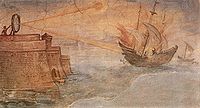
Another notable invention made by Archimedes was called the Archimedes' Screw. The purpose of this invention was to pump out water front he hulls of massive ships that were so heavy they would leak a considerable amount. So Archimedes took it upon himself to find a solution, and he did find a genius one at that. The Archimedes screw is a hollowed out cylinder with a screw/twisted platform coiling up the inside of the cylinder. The machine was hand cranked and proved very successful! This design is still in use today and has been since in many industries and factories. [3]
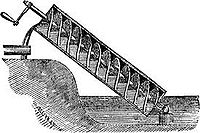
For more information, it will be in your interest to explore density and volume and other physical properties of matter, because Archimedes laid out the foundation for these concepts and allowed the advancement of knowledge to diverge into many different areas in physics and mathematics. Also, if you find yourself even more curious, try reading his actual works! They are very fascinating and ancient, but still relevant to how we perceive the world.
Further reading
See Archimedes' works which include "In Measurement of a Circle", "On Spirals", "On Floating Bodies", or a number of other works that managed to survive the years of world history.
External links
A. http://www.britannica.com/biography/Archimedes
B. https://www.cs.drexel.edu/~crorres/Archimedes/contents.html
C. http://www-history.mcs.st-and.ac.uk/Mathematicians/Archimedes.html
This section contains the the references you used while writing this page
1. https://www.google.com/imgres?imgurl=http://www-history.mcs.st-and.ac.uk/BigPictures/Archimedes_7.jpeg&imgrefurl=http://www-history.mcs.st-and.ac.uk/PictDisplay/Archimedes.html&h=326&w=293&tbnid=KHRomCtWY9sJYM:&tbnh=186&tbnw=167&docid=6nTRhMjzepOIkM&itg=1&client=safari&usg=__0bPfKo0mcCtMV3YhjrkZfv9b1Xo=
2. http://www.thefamouspeople.com/profiles/archimedes-422.php
3. https://en.wikipedia.org/wiki/Archimedes
4. https://en.wikipedia.org/wiki/Archimedes%27_screw
- Which Category did you place this in?
Navigation menu
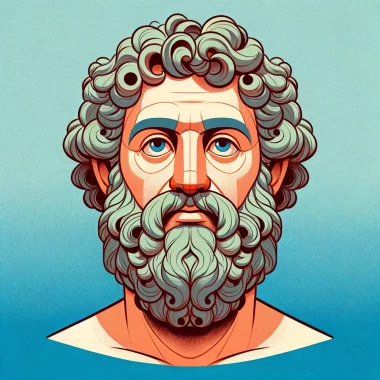
Archimedes was a Greek polymath: a major innovator in mathematics, geometry, physics, and engineering. He formulated the principle of leverage. He proved that fluids falling toward a central point will eventually form themselves into a sphere, an important contribution to the Ancient Greek hypothesis that the Earth was round (Christopher Columbus was by no means the first to this insight – by the time he came along, it had been understood by every educated person for almost two thousand years). He derived an extraordinarily precise value for the mathematical constant pi (π). And he famously developed a method for measuring the density of irregularly-shaped objects, which would prove extremely useful in spotting forgeries.
Like a lot of ancient and classical philosophers, Archimedes is a somewhat mysterious figure. Ancient people didn’t spend much time writing biographies, much less auto biographies, so there isn’t much evidence to go on. Only one contemporary biography was written, and no copies survive. We know that Archimedes lived in the 3 rd century BC, and that he spent most of his life in Syracuse, a Greek colony in Sicily near the Italian Peninsula. He appears to have come from a prominent family and may have been a relative of the Syracusan king.
Although we know almost nothing about Archimedes’ life, we do know something about his death. It seems that the great philosopher, who would have been about 75 by this time, was killed by soldiers of the Roman Republic when they laid siege to Syracuse as part of the Second Punic War. In one version of the story, the Roman soldiers had orders to capture Archimedes and bring them to their general. When the soldiers burst in on Archimedes, he was sketching out a geometric proof in the sand of his courtyard. Apparently the siege had not been enough to tear him from his work. Startled, he cried, “Do not disturb my circles!” and tried to prevent the soldiers from trampling over his intricate drawings. Taking this as resistance, the Romans immediately killed him.
Archimedes’ Ideas
Leverage and the archimedean point.
The idea of a lever is pretty intuitive: if you’re using a bar to pry something open, a longer bar will work better than a short one. If you’re throwing a lacrosse ball, a loner stick will throw it further than a short one. This basic principle underpins not only obvious levers like crowbars and wrenches, but also the wheel and axle, the archer’s bow, the shovel, and even the human arm. Obviously all of these inventions were more or less taken for granted by Archimedes’ time, but he was the first to formulate the underlying principle and to understand how all these different kinds of levers are connected. The principle of “leverage” goes back to his work.
To illustrate his principle, Archimedes famously said, “Give me a place to stand and I will move the world.” He meant that a long enough lever, with its fulcrum in the right place, could move any object, no matter how heavy. The problem, of course, was that Archimedes would have to be standing outside the world in order to move it, and with space travel thousands of years in the future that seemed flatly impossible.
Later philosophers, starting with Descartes, would use this image to describe problems of consciousness. In order for Archimedes to move the Earth, he would have to find a place outside of it to stand, and yet the very concept of standing seemed to require having the Earth underfoot. Descartes argued that there was a similar problem in understanding consciousness: in order to understand the nature of consciousness, we would have to find an “Archimedean point” outside of consciousness, from which we could see our object of inquiry. Yet any inquiry from outside of consciousness is impossible, since consciousness is a necessary precondition for inquiry itself. It’s a problem that dogs philosophers of consciousness to this day.
The Oxford Dictionary defines “eureka” as “a cry of joy or satisfaction when one finds or discovers something.” Greek for “I’ve found it,” it’s become the mantra of cartoon scientists in moments of epiphany. And that image goes directly back to Archimedes, who is said to have shouted it as he ran naked through the streets of Syracuse. Here’s what happened:
The king of Syracuse, Hiero, had commanded his goldsmith to fashion him a crown of pure gold. But he had no way to check whether the crown was really 100% pure, or whether his goldsmith had cheated him by alloying the gold with silver and pocketing the remainder. Everyone knew that gold was more dense than silver, so if you could compare the crown’s weight to its volume it would be easy to tell whether it was made from pure gold. Archimedes was the world expert on measuring volume, but his formulas only allowed for measuring the volume of regularly-shaped objects: cubes and cylinders and so on. Because the crown was an irregular shape, there was no way to measure its volume without melting it down, and thus no way to check its density and know what it was made from.
Archimedes went home, puzzled by the king’s question. As the night wore on, he got ready to take a bath, possibly to take his mind off the problem. But as he stepped into the bath, he noticed that the water level rose just a little bit when he immersed his body in the water. He realized in a flash that the volume of displaced water was precisely equal to the volume of his submerged body. Fluid volumes were easy to measure, since they could be forced into regular shapes like cylinders. So all he would have to do was put the crown in water, measure the displacement, and compare the resulting ratio to the known density of gold.
In a frenzy, he jumped out of the bath and ran all the way out into the street, shouting “Eureka! Eureka!” He informed the king of his discovery (one assumes he stopped to get dressed first) and the test was immediately performed. Archimedes’ test confirmed the king’s suspicions, proving decisively that the crown had been faked. We are left to guess what happened to the goldsmith.
In Pop Culture
In Disney’s The Sword in the Stone, Merlin’s talking owl is called Archimedes. The owl, however, doesn’t have much in common with the Greek philosopher. In one of his most prominent scenes, Archimedes the owl says to young Arthur: “Now, boy, flying is not merely some crude mechanical process! It’s a delicate art! Purely aesthetic. Poetry of motion.”
To the real Archimedes, that would have made no sense at all. To him, there was nothing more purely aesthetic than the mechanical processes of geometry and physics. There was nothing “crude” about them. In fact, studying these things was so aesthetically compelling to Archimedes that his last act was a desperate attempt to keep from being shaken out of his mathematical reverie.
a. A theory of consciousness
b. An estimation of the value of pi (π)
c. An explanation of the principle underlying wheels and archery bows
d. These were all accomplishments of Archimedes
a. A disgruntled student
b. Roman soldiers
c. Syphilis
d. No one knows for sure
a. “I’m a genius”
b. “My circles”
c. “I’ve found it”
d. “I’m gonna be rich”
c. Alexandria
Who is the Father of Mathematics?
Archimedes is known as the Father of Mathematics. Mathematics is one of the ancient sciences developed in time immemorial. A major topic of discussion regarding this particular field of science is about who is the father of mathematics.
Table of Contents
19 January 2021
Reading Time: 4 minutes
Archimedes is regarded as one of the most notable Greek mathematicians. He is known as the Father of Mathematics.
In this article, we will be dealing with a small introduction to the great mathematicians' lives of all time. The significant discoveries, concepts in mathematical science are the contributions of the father of mathematics. Any student who is enthusiastic about learning the techniques of mathematical problems would have ever wondered about who is the creator of mathematics.
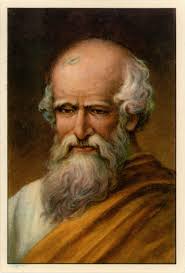
Life of Archimedes | Father of Mathematics
- Archimedes is considered the Father of Mathematics for his significant contribution to the development of mathematics. His contributions are being used in great vigour, even in modern times.
- Although a little is known about his birth, family, and early childhood, he is still considered one famous classical antiquity figure. He was born in 287 BC into an astronomer family and died in 212 BC in the Siege of Syracuse. Phidias is the name of his Astronomer father. He was born in Syracuse, which was a Greek colony at that time.
- From his childhood, Archimedes took an interest in studying science, mathematics, and politics. Throughout his entire life, Archimedes was fascinated with mathematical equations and problem-solving.
- Archimedes's family also supported him in getting a proper education. This was probably the reason for which he joined the School of Mathematics, which is in Egypt.
Downloadable PDF
Archimedes is a famous Greek Mathematician who is regarded as the Father of Mathematics, devoted his whole life to discovering mathematics and also science in his later life. Let us read more about his life.
Interesting facts on Archimedes
- There are several interesting facts about Archimedes. An award, namely 'The Fields Medal,' is designed with Archimedes’ image in memory of his contribution. This prestigious award is presented to the great mathematicians of their time.
- The name Archimedes received great popularity. As a result, an asteroid was named after this Greek scientist’s name. Besides these, there is a famous mountain range named after the famous Greek mathematician, the father of mathematics, known as Montes Archimedes. It is a mountain range situated on the Moon. The popularity of his name and discoveries increased in fever pitch day by day.
Notable Inventions of Archimedes- Father of Mathematics
- Archimedes is considered the father of mathematics because of his notable inventions in mathematics and science. He was in the service of King Hiero II of Syracuse.
- At that time, he developed many inventions. Archimedes made out a pulley system designed to help the sailors move objects up and down that are weighty.
- Archimedes has configured diverse mathematical concepts to solve mathematical problems. The 'method of exhaustion' is developed by Archimedes to measure the areas of shapes. Quantifying the value of PI is the result of his 'method of exhaustion.'
- This step of most outstanding achievement is used in mathematics to calculate the measurement of a circle. Through this method, Archimedes established the relationship between spheres and cylinders. He studied the area and surface of a circle as well as a parabola.
- Archimedes is one of the earlier mathematicians who studied the uses of prime numbers. He brought out the concept of infinity. He devised a weapon which is called the claw of Archimedes. This claw was made to defend the city wall's seaward portion against any sort of military assault. It was a defense mechanism to resist the attack of Roman general Marcellus.
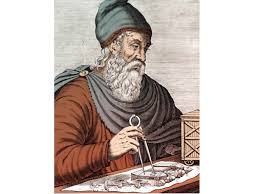
- Among his discoveries, Archimedes Screw is best known. Archimedes screw consists of an empty cylinder and a hollow spiral either inside or outside the cylinder. The screw, with its rotation, shifts the water from a lower plane place to a higher place.
- This invention was used to take away water from the hold of a ship. The Archimedes screw let water to flow upwards. In today’s date also, the Egyptian people are using this highly helpful method for the irrigation of crops. Farmers use this technique, especially in arid places.
- Archimedes principle is one of the major throwbacks in the history of Science. Archimedes's principle was conceived by the Greek mathematician while serving King Hieron. Behind this groundbreaking invention, there is a story of the king and Archimedes himself. King Hieron ordered or received a crown that is made of gold. But when he received it, he doubted it.
- He thought that it was silver instead of gold. The king offered Archimedes the responsibility to check whether it is of gold or silver. During the bath, Archimedes looked at the movement of the water body. He submerged the crown, and as a result, it displaces the water, which is equal to its volume.
- Archimedes became so excited and came up shouting ‘Eureka,’ ‘Eureka.’ He realized that an object’s size could be measured by placing it in water. It can be estimated through how much the water moved. In the latter period, it became famous as the Archimedes principle.
- Archimedes is a prominent figure in mathematics. His invention facilitated many more modern technological innovations. He wrote several works that helped in developing many concepts.
- His important works are like ‘On the Equilibrium of Planes,’ ‘On the Measurement of a Circle,’ ‘On Spirals,’ The Sand Reckoner.’ In the course of history, Archimedes made several contributions to the field of mathematics. Therefore, he is considered the 'father of mathematics' because of his important contribution to mathematics.
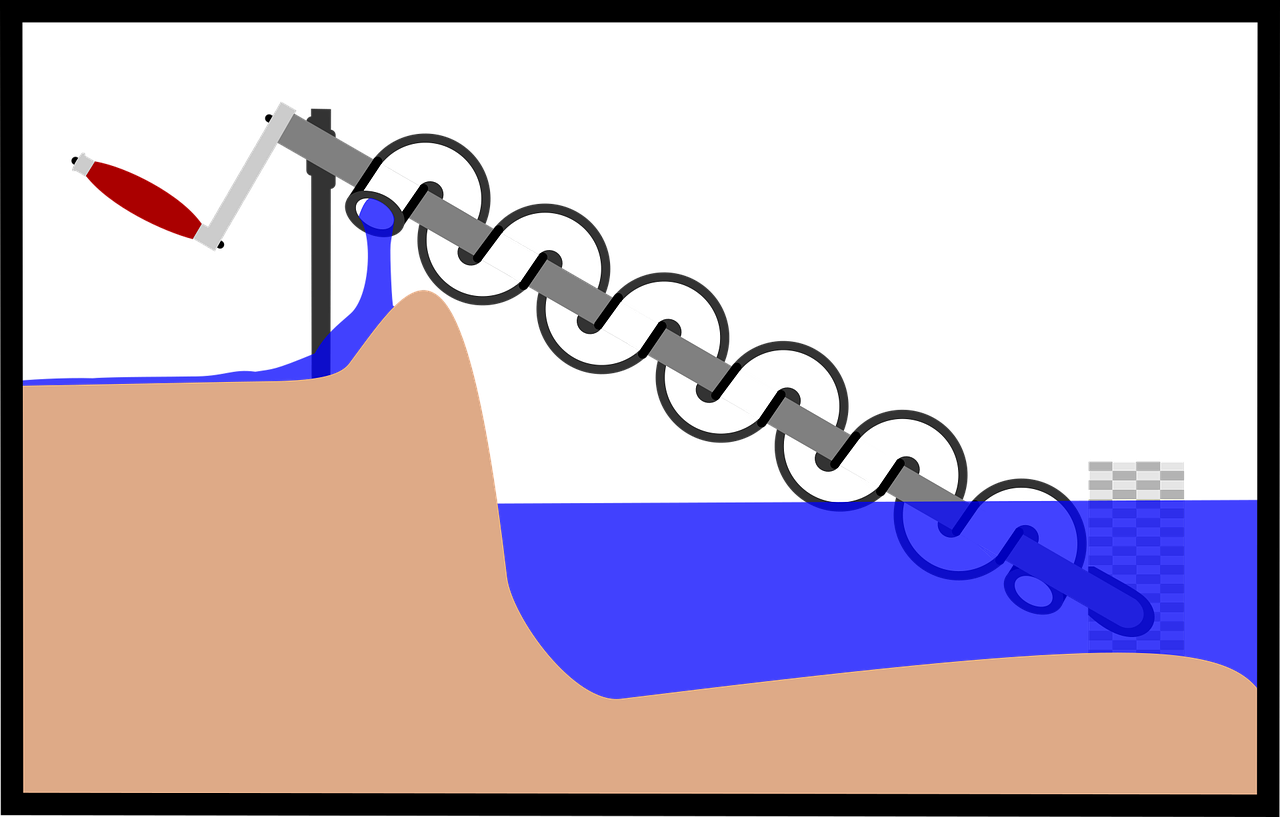
Death of the Father of Mathematics- Archimedes
Since Sicily was a Greek colony, it was frequently confronted with attacks of enemy nations. Once the Roman military leader Marcus Claudius Marcellus invaded Sicily where one of the Roman soldiers killed Archimedes. A soldier killed him in this Siege of Syracuse in 212BC.
There are several narratives concerning the story of the death of this well-known figure. According to a group of historians, soldiers attacked Archimedes because he mistakenly took the mathematical tools as a weapon.
Archimedes, who is the father of mathematics, served his lifetime, discovering various concepts, methods, and techniques in mathematics and science. Though he is not with us in person today, his inventions and ideas are greatly being used today.
His principles and ideas will remain with us to inspire future lovers of science. His excellences and reputation helped him to earn the title of ‘the father of mathematics.’ Today’s modern world would not have been so developed scientifically without the outstanding contribution of Archimedes.
His devotion and dedication towards science and mathematics molded and motivated the future generation to contribute to science and mathematics with many more discoveries and inventions. The present scientists can follow Archimedes' footprints, who is the father of mathematics, to contribute to society and bring laurels to the nation.
About Cuemath
Cuemath, a student-friendly mathematics and coding platform, conducts regular Online Classes for academics and skill-development, and their Mental Math App, on both iOS and Android , is a one-stop solution for kids to develop multiple skills. Understand the Cuemath Fee structure and sign up for a free trial.
FAQs on Archimedes - Father of Mathematics
What did archimedes discover.
In the 3rd Century BC, Archimedes : invented the sciences of mechanics and hydrostatics. He discovered the laws of levers and pulleys, which allow us to move heavy objects using small forces.
What is Archimedes famous for?
He is most famous for discovering the law of hydrostatics, sometimes known as ' Archimedes ' principle', stating that a body immersed in fluid loses weight equal to the weight of the amount of fluid it displaces.
A Dictionary of Greek and Roman biography and mythology William Smith, Ed.
("Agamemnon", "Hom. Od. 9.1", "denarius")
All Search Options [ view abbreviations ]
Hide browse bar Your current position in the text is marked in blue. Click anywhere in the line to jump to another position:
This text is part of:
- Greek and Roman Materials
View text chunked by:
- first letter : entry
Table of Contents:
Archime'des, equiponderants and centres of gravity, the quadrature of the parabola,, dimension of the circle, conoids and spheroids, on floating bodies, eutocius' commentary, translations, further information.
- Cicero, Letters to Atticus , 13.28
- Polybius, Histories , 8.5
- Polybius, Histories , 8.9
- Vitruvius, On Architecture , 10.11
- Vitruvius, On Architecture , 9.3
- Pliny the Elder, Naturalis Historia , 7.37
- Livy, The History of Rome, Book 24 , 34
- Livy, The History of Rome, Book 25 , 31
- Plutarch, Marcellus , 19
- Plutarch, Marcellus , 15
- Plutarch, Marcellus , 18
- Diodorus, Historical Library , 1.34
- Diodorus, Historical Library , 5.37
- Ovid, Fasti , 6
- 50 US States

58 Interesting Facts About Archimedes
Last updated on September 15th, 2023
Archimedes of Syracuse was a famous scientist and mathematician in Ancient Greek. Born in 287 BC in Syracuse, Greece then, but now in Italy, he was also an astronomer, engineer, physicist, and inventor. He is remembered for numerous innovations that still work today, including the Archimedes screw and lever system. While experimenting with hydrostatics and statics, he joined the list of the first scientists of classical antiquity to apply maths to physical situations. His contributions to calculus, geometry, and pulleys earned him the title ‘The Father of Maths and Mathematical Physics.’ This article highlights 58 interesting facts about Archimedes.
1. Archimedes’ Family Background is Almost Unknown
The only relative of Archimedes documented in his work (The Sandreckoner) is his father, Phidias, who was an astronomer. Archimedes is believed to have hailed from a noble family.
2. Archimedes Was a Relative of the Greek Tyrant of Syracuse
According to Plutarch, a Greek historian, Archimedes was related to King Hiero II of Syracuse, who ruled between 275 and 215 BC. Connections with the royal family enabled Archimedes to pay for his education.
3. Archimedes Went to Egypt for Formal Education
Archimedes went to a school founded by a Greek Mathematician ( Euclid ) in Alexandria, Egypt , where he majored in maths and physics. While studying, he became friends with renowned intellectuals: Eratosthenes of Cyrene, the Greek polymath and chief librarian at the Library of Alexandria, and Conon of Samos, the astronomer who named the constellation ‘Coma Berenices.’

4. Most of the Works of Archimedes are Found in Other Authors
His original work, which was in Doric Greek, did not survive. The world got to know Archimedes through the writings of famous authors. Seven treatises by Archimedes only existed through reference by such writers as Pappus of Alexandria and Johann Herwagen.
5. His Autobiography May Have Been Lost
Polybius was the first author to document Archimedes’ work, but he focused on the war machines that Archimedes invented. Polybius omitted the personal life story of the father of mathematics because it was published elsewhere and could not be traced. Heracleides, a friend of Archimedes, wrote his biography, but the records got lost.
6. His Work Focused on Explaining Why and How Things Work
Finding solutions was one of Archimedes’ favorite tasks. Voltaire acknowledged in his writing that Archimedes had a more imaginative mind than Homer, the poet.
7. Archimedes’ First Work Was on Geometry
He discovered a method of calculating the area within a circle and named it the principle of exhaustion. He is the wizard behind the theorem on spirals and formulas for determining volumes.

8. His Greatest Discovery Was the Archimedes’ Principle
The principle demonstrates how a ship floats on water instead of sinking, despite its heavy mass. This is also the law of floatation which accorded Archimedes another title – the father of hydrostatics.
9. The Pursuit of His Goals Took all His Attention and Energy
His undertakings completely consumed him to the extent that he forgot crucial chores like meal preparation, eating, and bathing. His quest for scientific knowledge is believed to have contributed to his death.
10. He Perfected Integration in Maths
Through the integration method, Archimedes could find areas, surface areas, and volumes of different shapes. He also conceived the topic of calculus , which was later perfected by Newton , Kepler, Fermat, and Cavalieri.
11. Archimedes Used to Tease Fellow Mathematicians
He knew that his prowess in maths was unmatched. So, he would give other mathematicians solutions to complex quizzes, but he wouldn’t show them how he arrived at the answers.
12. Archimedes Wrote More Than 20 Books
The works of Archimedes were primarily based on physics and mathematics. These include Archimedes’ Opera Omnia, The Method of Mechanical Theorems, On Spirals, Measurement of a Circle, The Life of Pi, S.Net, etc.

13. Archimedes May Have Written About Astronomy
Writers who came later suggested that Archimedes may have written manuscripts on astronomy, but none was published except the Sand-Reckoner.
14. Among Archimedes’ Achievements Is the Discovery of the Density Formula
Also called hydrostatic weighing, the density formula is a convenient method of calculating the volume of irregular objects. The approach is used today in construction.
15. He Set Out The Basic Principles of Mechanics
His writing ‘On Plane Equilibriums’ unveils the fundamental theories behind the center of gravity of two-dimensional figures. He dedicated this treatise to finding the center of gravity of trapeziums, triangles, and parallelograms.
16. He Attempted to Calculate the Number of Sand Grains in the Universe
In his Sand-Reckoner, Archimedes determined the size of the universe and tried to see how many grains of sand could fill the world. His idea was based on the heliocentric model that Aristarchus (an ancient astronomer of Samos) proposed.
17. He Inspired the Invention of the Solar Furnace
New evidence shows that Archimedes’ burning mirror (heat ray) functioned as the present-day solar furnace or heliostat. His device converged sun rays into a laser beam that was used to chase away the Roman fleet invading Syracuse in 212 BC. The laser beams were so powerful that they burned the enemy’s ships.

18. He Determined an Accurate Value for Pi
Archimedes examined the perimeter of a polygon inside and outside a circle. He noted that it is almost equal to the circumference of that circle. Through geometric and trigonometric theorems, he found an accurate way of estimating π (3.14), which has been used for centuries.
19. Archimedes’ Principle Compares to the Modern CBCT
CBCT (cone beam computed tomography) calculates the volume of teeth or pulp cavities. A recent study published in a journal of oral surgery, medicine, pathology, and radiology shows that CBCT uses some concepts in Archimedes’ principle.
20. He Was the First Mathematician to Calculate the Volume of a Sphere
The Greek scientist discovered that a sphere’s surface area and volume are two-thirds that of the smallest cylinder surrounding it. This was a significant milestone in the history of math.
21. His Gravestone Has a Sphere and Cylinder
His work meant a lot to him that he requested the mathematical proof engraved on his gravestone. The two shapes were sculpted on his tombstone, plus an inscription showing their relationship.
22. His Creativity Was Triggered by the Problems Presented by King Hiero II of Sicily
Archimedes made most of the discoveries by solving issues that King Hiero II posed. He was passionate, and his mind was constantly buzzing with maths and physics concepts.
23. He Founded the Law of Buoyancy Long Before the Concept of Force
Archimedes’ principle describes the resultant force when an object is submerged in a fluid wholly or partially. This force (displaced fluid) equals the weight of the object.
24. He Determined If the King’s Crown Was Pure Gold Through the Law Of Bouyance
King Hiero the Second summoned Archimedes to inspect whether his crown was genuine gold or mixed with silver. While in a bathtub, Archimedes realized that the overflowing water had a volume equivalent to the size of his body immersed in the bathtub. He applied this principle to determine the purity of the king’s crown.

25. He is Responsible for the Expression Eureka!
Eureka is a joyous Greek expression meaning ‘I have found it.’ When he realized the king’s gold had some impurities, Archimedes jumped out of a bath naked and shouted, “Eureka!” down the streets. The king punished the dubious goldsmith since he had used some silver in the design, making it lighter.
26. Some of his Books Are Partly in Greek and Latin (Translation)
Part of his script on On Floating Bodies is written in Greek, while the rest is translated into medieval Latin. The book explores hydrostatics. A few treatises were translated into Arabic around the 8 th century.
27. His Final Work Was Hidden Behind a Christian Ritual Book
According to Heath, Archimeds’ Method of Mechanical Theorems was found by Johan Heiberg in 1906 between the pages of a religious script. Older pages of the book had been scraped off and recycled.
28. He Demystified the Mechanism of the Lever
The lever is designed to rotate around the pivot. The farther the point is from the pivot, the faster it moves. Through geometric reasoning, Archimedes concluded that power is the product of speed and force.
29. He Made a Boastful Claim That He Can Overturn the Earth
With a befitting position, the lever can topple the earth , hypothetically speaking. Archimedes alleged in his work ‘On the Equilibrium of Planes’ that he would have to stand at a distance equivalent to 9 million light-years from the planet to overturn the planet.
30. Archimedes is Credited With the Invention of Astronomical Equipment
He is believed to have designed devices that helped identify the positioning and motions of planets, the moon , and the sun . One such apparatus was a bronze sphere that showed the location of other planets besides the earth, which was regarded as the center of the universe.

31. Archimedes Was Probably the Inventor of the Antikythera Mechanism
Since he developed many astronomical devices, Cicero claimed that Archimedes might have invented the Antikythera mechanism . This analog computer predicted eclipses and kept track of the revolving planets .
32. Archimedes’ Law of Straight Lines is More Than Just Geometry
The law proves that a straight line between two points is the shortest route between them. The principle also applies to real-life situations: simple and direct routes are the easiest ways to reach goals.
33. Archimedes’ Principle is the Basis of the Third Law of Motion by Sir Newton
It took 18 centuries before Isaac Newton understood Archimedes’ theorem. Newton explained why an object seems lighter when submerged in a fluid. According to Newton’s Law of Motion, every natural force produces an equal and opposite reaction.
34. He Is Thought to Have Invented the Odometer
In 27 — 23 BC, the Roman architect Vitruvius explained how the odometer measures the distance a vehicle has covered. However, Archimedes could have been the genius behind its invention around the First Punic War.
35. He Was the First to Use a Water Screw to Remove Water From a Leaky Ship
After building the king’s warship, it started leaking, and the king turned to him to solve the issue. Archimedes had to develop a new tool (water screw) to scoop water out of the vessel.
36. The Famous Archimedes Screw Forever Changed the World
It takes one person to transfer low-lying water upward to a canal with the Archimedes screw or the positive-displacement pump. The circular pipe that encloses a helix tilted at 45° raises the water when rotated. The screw pump also lifts heavy loads with minimal effort.
37. Archimedes Designed a Warship for King Hiero II
Upon the king’s request, the talented genius designed a vessel with a capacity of 1000 people and enough space for weapons. The ship could handle any war during the reign of King Hiero II.
38. He Is Responsible for the Compound Pulley That Moved an Entire Warship
A compound pulley comprises fixed and movable pulleys, giving it a mechanical advantage. Before its invention, people used ropes to hoist water. Between 287 and 212 BC, Archimedes created the first compound pulley, moving a warship full of soldiers with his strength.
39. He Invented a Ship Shaker to Defend Syracuse
The ship shaker, also known as Archimedes’ claw, was a superweapon featuring a crane-like arm with a giant metallic hook. When rivals approached, the claw was dropped to lift the ship upwards, release it, and sink it.
40. Worked on Hydraulics
Archimedes was also known for his work on hydraulics and mathematics. He is credited with being one of the first to study and describe how fluids flow through pipes. By doing so, he helped engineers in the hydraulic field.

41. The Heliocentric Theory
Archimedes was one of the first to propose a heliocentric theory, suggesting that the sun was the center of the universe rather than the earth. This idea was further developed by Copernicus and is now accepted as fact.
42. The Catapults
The developer invented the first catapult, a military weapon to launch projectiles. He used his knowledge of mathematics and mechanics to design powerful machines, such as the compound pulley and lever, to increase the range of his catapults.
43. Designed Siege Engines
Aside from the Claw of Archimedes, which lifted ships out of the water, Archimedes created a wide array of siege engines to protect Syracuse from Roman invasion. A steam cannon powered by boiling water is credited to him as the first primitive version.

44. A Naked Sculpture of Archimedes Sits in a Village in Hampshire
Statues that honor Archimedes are not only found in Italy. The Greek mathematician is also commemorated with a 9ft naked statue in Ellisfield, Hampshire.
. . . continue reading on the next page
- Privacy Policy
- Legal Disclaimer
- Report Error

IMAGES
VIDEO
COMMENTS
Archimedes (born c. 287 bce, Syracuse, Sicily [Italy]—died 212/211 bce, Syracuse) the most famous mathematician and inventor in ancient Greece.Archimedes is especially important for his discovery of the relation between the surface and volume of a sphere and its circumscribing cylinder.He is known for his formulation of a hydrostatic principle (known as Archimedes' principle) and a device ...
Biography Cicero Discovering the Tomb of Archimedes (1805) by Benjamin West. Archimedes was born c. 287 BC in the seaport city of Syracuse, Sicily, at that time a self-governing colony in Magna Graecia.The date of birth is based on a statement by the Byzantine Greek scholar John Tzetzes that Archimedes lived for 75 years before his death in 212 BC. In the Sand-Reckoner, Archimedes gives his ...
In the 3rd Century BC, Archimedes: • invented the sciences of mechanics and hydrostatics. • discovered the laws of levers and pulleys, which allow us to move heavy objects using small forces. • invented one of the most fundamental concepts of physics - the center of gravity. • calculated pi to the most precise value known.
Archimedes. January 10, 2024 by Muhammad Tuhin. Archimedes (c. 287-212 BCE) was an ancient Greek mathematician, physicist, engineer, and inventor. Renowned for his contributions to mathematics and physics, Archimedes is best known for his work on geometry, including the determination of the area of a circle and the volume of a sphere.
Polybius most likely omitted information on Archimedes' life because a biography (now lost) had already been published. ... Palimpsest is a manuscript discovered in 1906 of Archimedes' The Method and other works that had been reused to write a Christian liturgical text on. The Palimpsest has been restored using modern day imaging and digitizing ...
Archimedes was a mathematician, inventor, and astronomer who was one of the most celebrated mathematicians of all time. He was famous for getting so absorbed in his studies, that he forgot about social conventions. Famously, he is said to have realised a principle of mathematics when he saw the displaced water after getting in the bath.
Summary. Archimedes was the greatest mathematician of his age. His contributions in geometry revolutionised the subject and his methods anticipated the integral calculus. He was a practical man who invented a wide variety of machines including pulleys and the Archimidean screw pumping device. View twelve larger pictures.
Archimedes (Greek: Ἀρχιμήδης) (c. 287 B.C.E. -212 B.C.E.) was an ancient Greek mathematician, physicist, engineer, astronomer, and philosopher, considered one of the greatest mathematicians in antiquity.Archimedes apparently studied mathematics in Alexandria, but lived most of his life in Syracuse. He discovered how to find the volume of a sphere and determined the value of Pi ...
Why Archimedes was the greatest scientist of the Classical age. A mathematician, physicist, astronomer, inventor and engineer, the ancient Greek thinker Archimedes left a legacy much greater than a story about bathtubs, yelling "Eureka" and streaking nude down the street - even if, as Jonny Wilkes explores, it took a while for the rest of ...
Although many sought to find it, the calculation of pi, which is also expressed by the fraction 22/7, is commonly credited to Greek mathematician Archimedes of Syracuse more than 2,200 years ago ...
Archimedes calculated the most precise value of pi. The fraction 22⁄7 was his upper limit of pi; this value is still in use. Archimedes also discovered mathematically verified formulas for the volume and surface area of a sphere. How exponents could be used to write more significant numbers was shown by Archimedes.
Archimedes. Archimedes of Syracuse was an outstanding ancient Greek mathematician, inventor, physicist, engineer and also an astronomer. Although not much is known about his life, he is considered as one of the most eminent scientists and mathematicians of the classical era. He established strong foundations in the field of mathematics, physics ...
They write new content and verify and edit content received from contributors. The Editors of Encyclopaedia Britannica. Below is the article summary. For the full article, see Archimedes. Archimedes. Archimedes, oil on canvas by Giuseppe Nogari, 18th century; in the Pushkin Fine Arts Museum, Moscow. (more) Archimedes, (born c. 290-280 ...
Archimedes was an ancient Greek mathematician and inventor . He made mathematical discoveries as he solved everyday problems. He invented machines to move heavy objects, carry water, and fight battles. Archimedes recorded his discoveries so that others could learn from them. Today he is considered one of the greatest mathematicians of all time.
Archimedes. Born in 287 B.C. at Syracuse, Sicily, Archimedes was an engineer, physicist, and astronomer. Not only this, he was a notable scientist, who invented a wide range of machines, when machines were a rarity. One of the most famous mathematicians of all times, Archimedes revolutionized the subject of geometry. Though his exploits in the ...
The Life of Archimedes. Archimedes was born in Syracuse in 287 BC with Phidias as his father. The mother is not known. Archimedes was a famous Greek mathematician, engineer, inventor, physicist, and renowned thinker and problem solver. He laid the foundations for many prominent fields of physics and math such as hydrostatics and buoyancy.
Archimedes was a Greek polymath: a major innovator in mathematics, geometry, physics, and engineering. ... Bio. Like a lot of ancient and classical philosophers, Archimedes is a somewhat mysterious figure. Ancient people didn't spend much time writing biographies, much less autobiographies, so there isn't much evidence to go on. Only one ...
Archimedes is regarded as one of the most notable Greek mathematicians. He is known as the Father of Mathematics. In this article, we will be dealing with a small introduction to the great mathematicians' lives of all time. The significant discoveries, concepts in mathematical science are the contributions of the father of mathematics.
Definition. Archimedes (l. 287-212 BCE) was a Greek engineer and inventor who is regarded as the greatest mathematician of antiquity and one the greatest of all time. He is credited with a number of inventions still in use today (such as the Archimedes screw) and is referred to as the father of mathematics and mathematical physics. More about ...
Archime'des ( Ἀρχιμήδης), of Syracuse, the most famous of ancient mathematicians, was born B. C. 287, if the statement of Tzetzes, which makes him 75 years old at his death, be correct. Of his family little is known. Plutarch calls him a relation of king Hiero; but Cicero (Tusc. Disp. 5.23), contrasting him apparently not with Dionysius (as Torelli suggests in order to avoid the ...
Heracleides, a friend of Archimedes, wrote his biography, but the records got lost. 6. His Work Focused on Explaining Why and How Things Work. Finding solutions was one of Archimedes' favorite tasks. Voltaire acknowledged in his writing that Archimedes had a more imaginative mind than Homer, the poet. 7. Archimedes' First Work Was on Geometry